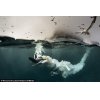
This year Scapa Flow is thriving with wildlife above and below the water line MV Invincible
published: 16:58:58 28/11/2016
This year we have had a lot of reports from our divers on-board that Scapa Flow is thriving with wild life from Lobsters to Crabs to Pollock and Cod, there seems to be a lot more down there compared to 10 years ago. This trend has been happening over the last few years and every year the wildlife seems to be growing from strength to strength.
The last 2 years we have seen a number of pods of Orcas in Scapa Flow hunting down the seal population. Quite often seen around The Barrel of Butter and also seen hunting for seals around Stromness Harbour and Hoy Sound.
We seem to get the same pods arriving each year....we are almost on first name terms! It makes for a good photo opportunity and the best times for the Orcas is April to June.
Orkney is renowned for its birds, particularly its fantastic sea birds and occasional rare visitors. Birds can be seen all over Orkney, some of which are not found anywhere else in Scotland or Britain.
 This year also seen for the first time was 4-5 large flocks of Gannets coming from Shetland to visit Scapa Flow. Quite often we see the Gannets dive bombing our divers whilst they are on their deco stops and after their dive.
This year also seen for the first time was 4-5 large flocks of Gannets coming from Shetland to visit Scapa Flow. Quite often we see the Gannets dive bombing our divers whilst they are on their deco stops and after their dive.
They can plunge into the sea to fish from a height of 100 feet, hitting the water up to 66 mph. The main reason for the success of the species is that it eats a wide variety of fish. The Gannet (Morus Bassanus) always breeds in colonies on isles and inaccessible cliffs. It is while it is diving or in flight or gliding with outstretched wings that this bird is at its most spectacular, with its wingspan of 6 ft.
 There is also a return of 2 Sea Eagles in Orkney nesting on the cliffs of Hoy, they have not been resident here for over 100 years. These eagles are the largest birds of pray in the UK and have a wing span of around 8 ft and they are a magnificent sight to see, gliding over the landscape and they take around 5 years to mature enough to breed.
There is also a return of 2 Sea Eagles in Orkney nesting on the cliffs of Hoy, they have not been resident here for over 100 years. These eagles are the largest birds of pray in the UK and have a wing span of around 8 ft and they are a magnificent sight to see, gliding over the landscape and they take around 5 years to mature enough to breed.
Ian even has his own pet sea gull that likes to spend his days sitting on top of the wheel house keeping a watch full eye on the skipper! Towards the end of the diving session we are lucky enough to see the Northern Lights with longer periods of darkness and the frequency of clear nights, this is probably the best time of the year to experience the auroral displays. Nights need to be cold and the sky clear of clouds, with limited light pollution and increased solar activity.
Towards the end of the diving session we are lucky enough to see the Northern Lights with longer periods of darkness and the frequency of clear nights, this is probably the best time of the year to experience the auroral displays. Nights need to be cold and the sky clear of clouds, with limited light pollution and increased solar activity.
